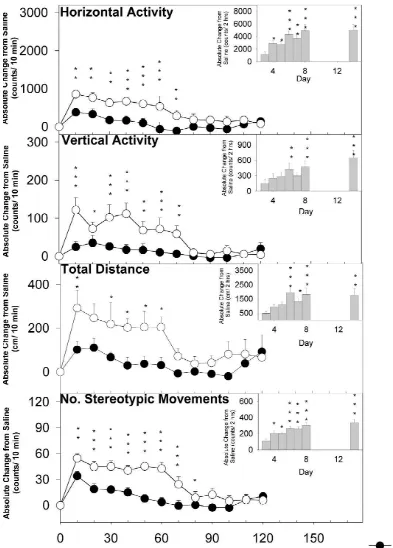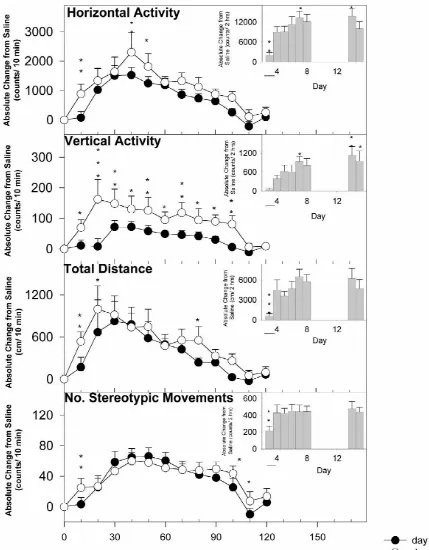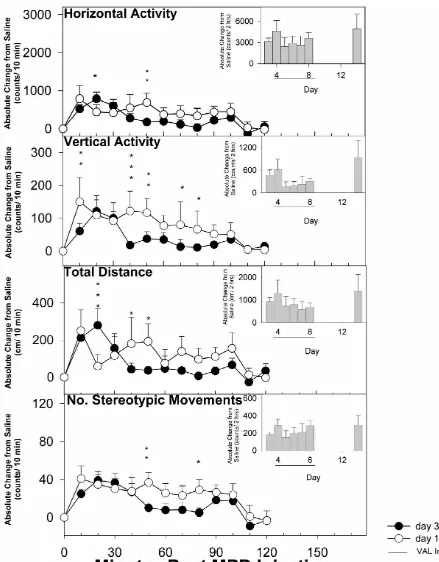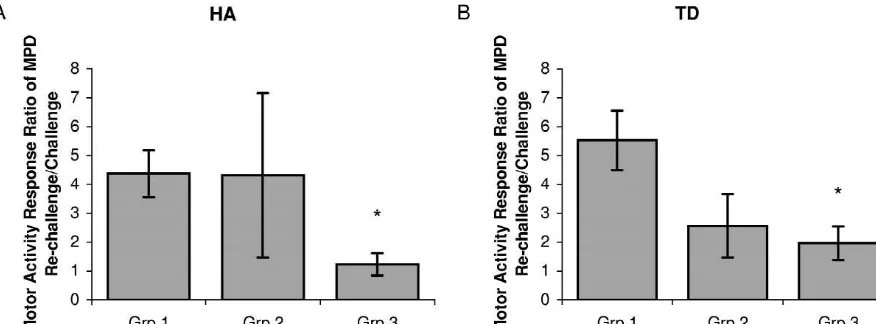www.elsevier.com / locate / bres
Research report
Valproate prevents the induction of sensitization to methylphenidate
(ritalin) in rats
a,b a a,b a b ,
*
Pamela Yang
, Anitra Beasley , Kary Eckermann
, Alan Swann , Nachum Dafny
a
Department of Psychiatry and Behavioral Sciences, The University of Texas Medical School at Houston, PO Box 20708, Houston, TX 77225, USA
b
Department of Neurobiology and Anatomy, The University of Texas Medical School at Houston, PO Box 20708, Houston, TX 77225, USA
Accepted 19 September 2000
Abstract
Repetitive exposure to methylphenidate (MPD) elicits sensitization to its locomotor effects. Drugs that affect the GABA system may modify adaptations to drug exposure. Therefore, we have examined the effect of sodium valproate, which enhances GABA function, on the development of sensitization to MPD using an automated, computerized animal activity monitoring system to record each rat’s motor activities for 15 consecutive days. Rats were recorded before and after saline injection (Days 1–2) to provide baseline activity. Animals were then randomly assigned to the following three groups that received: (1) 2.5 mg / kg MPD (s.c.) for six consecutive days (Days 3–8), (2) a single dose of valproate (50 mg / kg; i.p.) 1 h prior to the first (Day 3) of six daily doses of MPD (2.5 mg / kg; s.c.), or (3) five daily doses of valproate (50 mg / kg, i.p.) 1 h prior to MPD (2.5 mg / kg, s.c.) on Days 4–8. There was no drug treatment during the next 5 days (Days 9–13). All rats were then re-challenged with MPD (2.5 mg / kg, s.c.) on Day 14. Group 2 rats were also re-challenged with 50 mg / kg valproate followed by 2.5 mg / kg MPD 1 h later on Day 15. Administration of MPD alone produced a sensitized response. Multiple valproate injections prevented the induction of MPD-elicited sensitization in all four motor indices, while a single valproate injection prevented the induction of MPD-elicited sensitization in two of four motor indices studied. In conclusion, a single injection 50 mg / kg valproate given prior to any MPD treatment partially blocked the induction of MPD sensitization while repeated injections of valproate co-administered with MPD treatment completely prevented this effect. 2000 Elsevier Science B.V. All rights reserved.
Theme: Neurotransmitters, modulators, transporters, and receptors
Topic: Behavioral pharmacology
Keywords: Sensitization; Locomotor activity; Psychostimulants; GABA; Dopamine
1. Introduction Increased locomotor activities and stereotypic movements incited by dopaminergic stimulation can be blocked by GABA agonists at doses where these agonists have no Repeated administrations of psychomotor stimulants
direct effects [7,28]. Clonazepam, a potent GABA-benzo-such as amphetamine, cocaine [20,21], and
methylpheni-diazepine agonist, was reported to prevent the development date [11] have been shown to cause behavioral
sensitiza-of stimulant-induced sensitization [16]. Sodium valproate, tion. Behavioral sensitization is characterized by an
in-an in-anticonvulsin-ant drug used in treating schizophrenia in-and creased locomotor and / or stereotypic behavior resulted
mania [24], can enhance GABA activity and has effects from repetitive treatment over time to a given dose of a
similar to that of benzodiazepine derivatives in conditional stimulant [27]. Systemic administration of GABA agonists
avoidance response studies [26]. The present study was reduces dopamine turnover in the mesolimbic system [2].
carried out to determine whether enhancement of GABA activity from a single pretreatment of valproate prior to any MPD administration or multiple doses of valproate
*Corresponding author. Tel.: 11-713-500-5616; fax: 1
1-713-500-given 1 h before MPD administration would prevent the
0621.
E-mail address: [email protected] (N. Dafny). induction of locomotor sensitization to MPD.
2. Materials and methods which grouped them into several different locomotor indices. Animal activity was recorded continuously for 15
2.1. Subjects days.
The following four locomotor indices were analyzed: (1) Male Sprague–Dawley rats (N528; Harlan, Houston, horizontal activity (HA), which measured the overall TX), weighing from 180 to 230 g, were housed in groups motor activity in the lowest tier of the testing cages and of four in Plexiglas cages inside the experimental room on assessed the overall amount of motor activity, (2) total a 12-h light / dark schedule (light on at 07:00 h). The distance (TD), which recorded the specific motor behavior experimental room was maintained at an ambient tempera- of forward movement, (3) vertical activity (VA) which ture of 21628C and at a relative humidity of 37–42%. counted the specific instances of rearing, and (4) number After a minimum of 48 h of habituation, each rat was of stereotypes (NOS) which determined the stereotypic randomly placed inside a test (home) cage where its behaviors, measured by repeated interruption of the same locomotor activity recording began in all groups after 24 h beam [10].
of acclimation to the home cages and continued for 15
days. Rats were supplied with food pellets and water ad 2.4. Control and treatment groups libitum.
There were three experimental groups: Group 1 (N512)
2.2. Drugs — after baseline and saline, animals treated with 6 days of
MPD followed by five washout days and MPD re-chal-Both sodium valproate (VAL; Research Biochemicals lenge on Day 14 (Table 1); Group 2 (N58) — similar to International, Natick, MA) and methylphenidate hydro- Group 1 but, in addition, animals were given a single chloride (MPD; Sigma Chemicals, St Louis, MO) were administration of valproate (50 mg / kg) on Day 3 and Day dissolved in 0.9% saline. Valproate was injected intraperi- 15 1 h prior to MPD; and Group 3 (N58) — multiple toneally (i.p.), while MPD was injected subcutaneously administrations of valproate (50 mg / kg) was given on (s.c.). All injections were of equal volume (0.8 ml) and Days 4–8 1 h prior to each dose of MPD (Table 1). The given between 12:00 h and 14:00 h. The selected valproate following is the general protocol for these groups: Day 1 dose was 50 mg / kg and MPD dose was 2.5 mg / kg. These — baseline activity; Day 2 — saline injection (0.9%, i.p.); dosages were selected based on previous dose–response Day 3 — Groups 1 and 3 were treated with MPD, Group 2 studies [8,10,11]. It was shown in preliminary studies that was given valproate 1 h prior to MPD; Days 4–8 — the dose of valproate chosen had no motor effect of its Groups 1 and 2 were treated with daily MPD, Group 3 was
own [8]. given valproate 1 h prior to daily MPD on Days 4–8; Days
9–13 — washout for all three groups; Day 14 — MPD
2.3. Apparatus was given to all three groups; and Day 15 — valproate 1 h
prior to MPD was given to Group 2. A computerized animal activity monitoring (CAAM,
AccuScan Instruments, Inc., Columbus, OH) system was 2.5. Data analysis used to record locomotor activities continuously
through-out the 15 experimental days [10]. The activity chambers Variability in baseline activity among animals was consisted of clear acrylic open field boxes (40.5340.53 observed; therefore, the best comparison for the drug 31.5 cm) with two levels tiers, each consists of 16 infrared effects is to have each animal served as its own control. beams. The first and second levels of the tiers were placed The drug effect for each motor index was determined by 6 and 12.5 cm from the cage floor, respectively. The subtracting the activity score of the 2-h after saline CAAM recorded any interruption of each of the beams at a injection (Day 2) from that of the 2 h after MPD injection frequency of 100 Hz. The interruption of any beam was to eliminate any handling and injection effects [10–12]. counted. Total counts were compiled and downloaded Thus, the activity of saline injection served as baseline and every 10 min into the OASIS data collection program, the absolute change in activity from saline represented
Table 1
effects of the drugs. For Groups 1 and 3, the presence of In the line graph (Fig. 1), each 10-min sample on Day 3 sensitization in each treatment group was determined by was compared to the same sample on Day 14 for the initial comparing results of Days 4 to 8 and 14 with that of MPD 120 min following MPD administration. With respect to challenge on Day 3 (first day of MPD administration in HA and VA, the first seven samples (i.e., 70 min after
¨
naıve animals) within that group. For Group 2, the MPD injection) significantly differed in Days 3 and 14 presence of sensitization was determined by comparing (P,0.01). For TD, five of the initial samples of Day 14 results of Days 5 to 8 and 14 to 15 with that of Day 4 after MPD treatment differed significantly from Day 3. (second day of MPD administration, without valproate). The differences in Day 3 and 14 were strongest in NOS Results were subjected to a within-group repeated measure with the first seven samples (70 min after injection; P,
analysis of variance (ANOVA, two levels: treatment day 0.001). Thus, MPD induced activities were greatest within and 10 min sample). The significant differences in in- the first 70 min after drug injection.
dividual 10-min samples were determined with post-hoc
Fischer’s (LSD) method. Significance for all of the above 3.2. Single administration of valproate comparisons was set at *P,0.05, **P,0.01, or ***P,
0.001. Values are presented as the mean6S.E.M. for each The effect of a single dose of valproate given 1 h prior 10 min after injection or for the sum of 2-h sample. In to MPD injection on Day 3 is summarized in Fig. 2. A addition, the difference in the magnitude of motor re- single injection of valproate given prior to any MPD sponses was also determined by calculating the ratio of the treatment prevented the induction of MPD sensitization for absolute change in activity between MPD challenge (Day TD and NOS as expressed in the first 2 h after MPD 3 for Groups 1 and 3; Day 4 for Group 2) and MPD injection. However, there were significant differences on re-challenge (Day 14). Results were analyzed using re- Day 7 (Fig. 2 bar graph) and 14 from Day 3 with respect to peated measure analysis of variance (one-way ANOVA: HA (P,0.05) and VA (P,0.05 for Day 7; P,0.01 for treatment day), and any significant difference between the Day 14); thus, a single valproate injection did not prevent groups was determined with the Dunnett test. Significance the induction of MPD-sensitization for these indices. The for this comparison was set at *P,0.05. effects of the second injection of valproate 1 h prior to MPD (Day 15) also differed significantly from the effects of the first valproate injection 1 h prior to MPD (Day 3;
3. Results P,0.05) for VA, while there were no significant differ-ences for the other three indices. Therefore, a single
3.1. Control injection of valproate prior to any MPD injection
pre-vented the induction of sensitization to TD and NOS but Time control (15 days) and saline injection (Days 2 to not to HA and VA.
8) on identical experimental protocols showed that the
motor indices studied had remained similar over time as 3.3. Multiple administration of valproate well as following multiple saline injections, and any
deviation from the time control or saline treatment was the The effect of multiple injections of valproate 1 h prior to result of the drug effect(s) [6,10,12]. The effects of MPD injections on Days 4 to 8 on the induction of MPD repeated MPD (2.5 mg / kg) treatment for HA, TD, VA, and sensitization is summarized in Fig. 3. The total count of 2 NOS are summarized in Fig. 1. The bar graph shows the h after MPD injection of Days 4 to 8 compared to Day 3 total activity score for the 2 h after MPD injection exhibited no significant differences in locomotor activity throughout the experimental protocol. The line graph between any of the days with respect to HA, TD, VA, and represents the 10-min temporal response over the 2 h after NOS. Thus, concurrent administration of MPD and val-MPD injection on Days 3 and 14. In general, val-MPD’s proate prevented the development of MPD sensitization. effects on motor activity differed significantly between
Day 3 (the initial challenge day) and Days 4 to 8 (the 3.4. Magnitude of sensitization between groups induction days) and Day 14 (the re-challenge day). For
Fig. 4. This figure shows the motor activity response ratio of MPD re-challenge and challenge for Groups 1–3 and the statistical comparison between these groups. (a) shows that multiple administration of valproate (Group 3) significantly (P,0.05) decreased the horizontal activity (HA) response ratio of MPD re-challenge and challenge compared to that of Group 1; while there is no difference in the HA response ratio for Group 2, which received a single administration of valproate, when compared to Group 1. Similar results are shown in (b) involving total distance (TD) response.
4a). These observations indicate that multiple administra- tration prevented the induction of MPD-sensitization in all tion of valproate prevented MPD-elicited sensitization. four motor indices throughout the 6 days of repeated MPD treatment and in the MPD re-challenge on Day 14. Interestingly, in a comparison of between groups involving
4. Discussion the motor activity response ratio of MPD re-challenge and challenge, it was found that multiple administration of Methylphenidate has the potential of abuse because it valproate (Group 3) prevented MPD-elicited sensitization has pharmacological stimulant properties similar to am- compared to the administration of MPD alone (Group 1) as phetamine and cocaine [9,31]. Its use in the treatment of demonstrated in the HA and TD responses (Fig. 4a). attention deficit / hyperactivity disorder (ADHD) has drasti- However, single administration of valproate (Group 2) did cally increased over the years [15]. The chronic use of not prevent MPD-elicited sensitization compared to the psychostimulants, such as amphetamines, has been re- administration of MPD alone (Fig. 4b). These observations ported to produce a progressive enhancement in paranoid further support the efficacy of multiple treatments of behaviors that can result in psychosis [18,27] and in a valproate in blocking behavioral sensitization.
reciprocal cross-sensitization between itself and other Behavioral sensitization consists of two phases: initia-stimulants [4], which may be analogous to sensitization in tion / induction and expression. There is evidence
sug-rodents [27]. gesting that the induction and the expression of
sensitiza-The results show that daily repeated administration of tion to psychostimulants involve different anatomical and MPD (2.5 mg / kg) for six consecutive days produced physiological mechanisms. The initiation of sensitization sensitization to its effects on locomotor and stereotypic consists of the immediate molecular and / or cellular effects behavior from the second or fourth injection, which that induce behavioral sensitization and are altered by drug persisted when rats were re-challenged with MPD on Day actions in the somatodendritic regions of the A10 /A9 14. Similar behavioral sensitization has been reported dopamine neurons [18]. In contrast, changes in dopamine following multiple treatment with MPD [11] and other transmission within the nucleus accumbens seem to be psychostimulants such as amphetamine and cocaine responsible for the expression of sensitization, which refers [19,27]. The objective of the present study was to de- to the long-term consequences of molecular and / or cellular termine whether a single or multiple administration of effects that induce behavioral sensitization [18].
the regulation of the activity of dopamine neurons by sensitization [34]. Moreover, there is evidence that excitat-reducing dopamine release and inhibiting dopaminergic ory amino acids, particularly N-methyl-D-aspartate activity [1]. GABAergic neurons in the A10 /A9 region (NMDA), may be essential for the development of a play an important role in the modulation of the D1 sensitized response [32]. Pretreatment with dizocilpine receptors that are involved in the initiation of behavioral (MK-801), a non-competitive N-methyl-D-aspartate
sensitization [18]. (NMDA) receptor antagonist, prior to amphetamine [20] or
g-Aminobutyric acid agonists have been shown to block methylphenidate injection [13,29] prevented the induction the augmented locomotor activity and stereotyped behavior of behavioral sensitization produced by these drugs but not resulting from dopaminergic stimulation [1,7,28]. Bac- the expression of behavioral sensitization [32]. Therefore, lophen, a specific GABAb agonist agent, was found to it was suggested that the disruption of glutamatergic block the effect of amphetamine on discriminative learning projections to dopamine terminal fields may affect the in rats [3]. Locomotor stimulation in rodents induced by induction of sensitization [18] and that the induction and amphetamine or apomorphine was also inhibited by the expression of behavioral sensitization involve separate GABAergic drugs [2]. In the present study, multiple mechanisms [20]. Our results suggest that stimulation of administration of valproate prevented the induction of GABA activity, like inhibition of NMDA receptors, pre-MPD sensitization in all four motor indices studied. vented induction of behavioral sensitization.
However, a single administration of valproate given 1 h before the initial MPD treatment prevented the induction
of sensitization to MPD in total distance and number of Acknowledgements
stereotypic movements but not in horizontal and vertical
activities. Valproate treatment enhanced GABA activity The authors wish to thank Dr. Miguel Bedolla for his within the brain [25] by inhibiting its degradation, help with the statistics. This study was supported in part by stimulating its synthesis and release, and directly enhanc- the Pat Rutherford Chair in Psychiatry.
ing its postsynaptic effect [24]. Therefore, valproate may have prevented sensitization to MPD by increasing
GABAergic function. In addition to enhancing GABA References
activity, valproate has also been reported to enhance 1 21
voltage-dependent inward currents involving Na , Ca , [1] A. Agmo, C. Belzung, M. Giordano, Interactions between dopamine
1 and GABA in the control of ambulatory activity, J. Neural Transm.
and K in the neocortex [35]. This effect might represent
103 (1996) 925–934.
another possible mechanism of action for valproate.
[2] A. Agmo, A. Medrano, N. Garrido, P. Alonso, GABAergic drugs
In similar experimental protocols, multiple injections of inhibit amphetamine-induced distractibility in the rat, Pharmacol. valproate given after the induction of MPD sensitization Biochem. Behav. 58 (1997) 119–126.
prevented the expression of behavioral sensitization (Days [3] S. Ahlenius, A. Carlsson, J. Engel, Antagonism by baclophen of the
D-amphetamine induced disruption of a successive discrimination in
9 to 13) as measured by both total distance and vertical
the rat, J. Neural Transm. 36 (1975) 327–333.
activity but not horizontal activity or number of stereotypic
[4] M.L. Aizenstein, D.S. Segal, R. Kuczenski, Repeated amphetamine
[33]. However, a single administration of valproate given and fencamfamine: sensitization and reciprocal cross-sensitization, on Day 9 after MPD sensitization did not prevent the Neuropsychopharmacology 3 (1990) 283–290.
expression of behavioral sensitization to MPD in any of [5] S.G. Amara, M.J. Kuhar, Neurotransmitter transporters: recent progress, Annu. Rev. Neurosci. 16 (1993) 73–93.
the four motor indices studied [33]. These observations
[6] J. Bjork, O. Gaytan, N. Patt, A. Swann, N. Dafny, Behavioral
suggest that the effects of valproate on the induction of
tolerance to and withdrawal from multiple fluxetine administration,
MPD sensitization are different from those on the expres- Int. J. Neurosci. 93 (1998) 163–179.
sion of MPD sensitization. The difference in the timing of [7] J. Cott, J. Engel, Suppression by GABAergic drugs of the locomotor
valproate injection also supports the hypothesis that the stimulation induced by morphine, amphetamine, and apomorphine: evidence for both pre- and post-synaptic inhibition of catecholamine
induction and the expression of behavioral sensitization to
systems, J. Neural Transm. 40 (1977) 253–268.
MPD involve different mechanisms. Thus, the results of
[8] K. Eckermann, O. Gaytan, A. Beasley, A. Swann, N. Dafny,
this study suggest that repeated co-administration injection Dose-related modulation on the acute and chronic effects of of valproate with MPD prevented the induction of sensiti- methylphenidate by valproic acid, Proc. Soc. Neurosci. 25 (1999)
zation to MPD more effectively than the expression of 1877.
[9] D.N. Franz, Central nervous system stimulants, in: L.S. Goodman,
sensitization, perhaps via increased GABA activity.
A. Gilman (Eds.), The Pharmacological Basis of Therapeutics,
The above observation suggests that the induction and
MacMillan, New York, 1975, pp. 359–366.
the expression of behavioral sensitization for stimulants [10] O. Gaytan, D. Ghelani, S. Martin, A. Swann, N. Dafny, Dose may have different neuronal mechanisms. It was reported response characteristics of methylphenidate on different indices of
that lesions of the fornix, which resulted in interrupted rats locomotor activity at the beginning of the dark cycle, Brain Res. 727 (1996) 3–21.
projections from the hippocampus to nucleus accumbens,
[11] O. Gaytan, S. al-Rahim, A. Swann, N. Dafny, Sensitization to
prevented the induction of locomotor sensitization, while
locomotor effects of methylphenidate in the rat, Life Sci. 61 (1997)
[12] O. Gaytan, A. Swann, N. Dafny, Time-dependent differences in the psychiatric disorders: literature review and clinical guidelines, J. rat’s motor response to amphetamine, Pharmacol. Biochem. Behav. Clin. Psychiat. 50 (Suppl.) (1989) 23–29.
59 (1998) 459–467. [25] J.K. Penry, J.C. Dean, The scope and use of valproate in epilepsy, J. [13] O. Gaytan, R. Nason, R. Alagugurusamy, A. Swann, N. Dafny, Clin. Psychiat. 50 (Suppl.) (1989) 17–22.
MK-801 blocks the development of sensitization to the locomotor [26] K.S. Rayevsky, A.N. Kharlamov, GABA-ergic drugs: effects on effects of methylphenidate, Brain Res. Bulletin 51 (2000) 1–8. conditioning, memory and learning, Pharmacol. Res. Comm. 15 [14] B. Giros, M. Jaber, S.R. Jones, R.M. Wightman, M.G. Caron, (1983) 85–96.
Hyperlocomotion and indifference to cocaine and amphetamine in [27] T.E. Robinson, J.B. Becker, Enduring changes in brain and behavior mice lacking the dopamine transporter, Nature 379 (1996) 606–612. produced by chronic amphetamine administration: a review and [15] L.S. Goldman, M. Genel, R.J. Bezman, P.J. Slanetz, Diagnosis and evaluation of animal models of amphetamine psychosis, Brain Res.
treatment of attention-deficit / hyperactivity disorder in children and 396 (1986) 157–198.
adolescents, J. Am. Med. Assoc. 279 (1998) 1100–1107. [28] M.R. Sandoval, J. Palermo-Neto, Effect of manipulation of the [16] K. Ito, T. Ohmori, T. Abekawa, T. Koyama, Clonazepam prevents GABA system on dopamine-related behaviors, Braz. J. Med. Biol.
the development of sensitization to methamphetamine, Pharmacol. Res. 28 (1995) 88–99. Biochem. Behav. 58 (1997) 875–879.
[29] S. Sripada, O. Gaytan, S. Al-rahim, A. Swann, N. Dafny, Dose-[17] S.R. Jones, R.R. Gainetdinov, M. Jaber, B. Giros, R.M. Wightman,
related effects of MK-801 on acute and chronic methylphenidate M.G. Caron, Profound neuronal plasticity in response to inactivation
administration, Brain Res. 814 (1998) 78–85. of the dopamine transporter, Proc. Natl. Acad. Sci. USA 95 (1998)
[30] D. Taylor, B.T. Ho, Comparison of inhibition of monoamine uptake 4029–4034.
by cocaine, methylphenidate, and amphetamine, Res. Commun. [18] P.W. Kalivas, J. Stewart, Dopamine tranmission in the initiation and
Chem. Pathol. Pharmacol. 21 (1978) 67–75. expression of drug- and stress-induced sensitization of motor
[31] N.D. Volkow, Y.S. Ding, J.S. Fowler, G.J. Wang, J. Logan, J.S. activity, Brain Res. Rev. 16 (1991) 223–244.
Gatley, S. Dewey, C. Ashby, J. Liebermann, R. Hitzemann, A.P. [19] P.W. Kalivas, J.E. Alesdatter, Involvement of N-methyl-D-aspartate
Wolf, Is methylphenidate like cocaine? Studies on their phar-receptor stimulation in the ventral tegmental area and amygdala in
macokinetics and distribution in the human brain, Arch. Gen. behavioral sensitization to cocaine, J. Pharmacol. Exp. Ther. 267
Psychiat. 52 (1995) 456–463. (1993) 486–495.
[32] M.E. Wolf, The role of excitatory amino acids in behavioral [20] R. Karler, I.A. Chaudhry, L.D. Calder, S.A. Turkanis, Amphetamine
sensitization to psychomotor stimulants, Prog. Neurobiol. 54 (1998) behavioral sensitization and the excitatory amino acids, Brain Res.
679–720. 537 (1990) 76–82.
[33] P. Yang, A. Beasley, A. Swann, N. Dafny, Valproate modulates the [21] R. Karler, L.D. Calder, J.B. Bedingfield, Cocaine behavioral
sensiti-expression of methylphenidate (ritalin) sensitization, Brain Res. 874 zation and the excitatory amino acids, Psychopharmacology 115
(2000) 216–220. (1994) 305–310.
[34] T. Yoshikawa, A. Watanabe, H. Shibuya, M. Toru, Involvement of [22] R. Karler, L.D. Calder, L.H. Thai, J.B. Bedingfield, The
dopa-the fimbria fornix in dopa-the initiation but not in dopa-the expression of minergic, glutamatergic, GABAergic bases for the action of
amphet-methamphetamine-induced sensitization, Pharmacol. Biochem. amine and cocaine, Brain Res. 671 (1995) 100–104.
Behav. 45 (1993) 691–695. [23] R. Kuczenski, N.J. Leith, Chronic amphetamine: is dopamine a link




